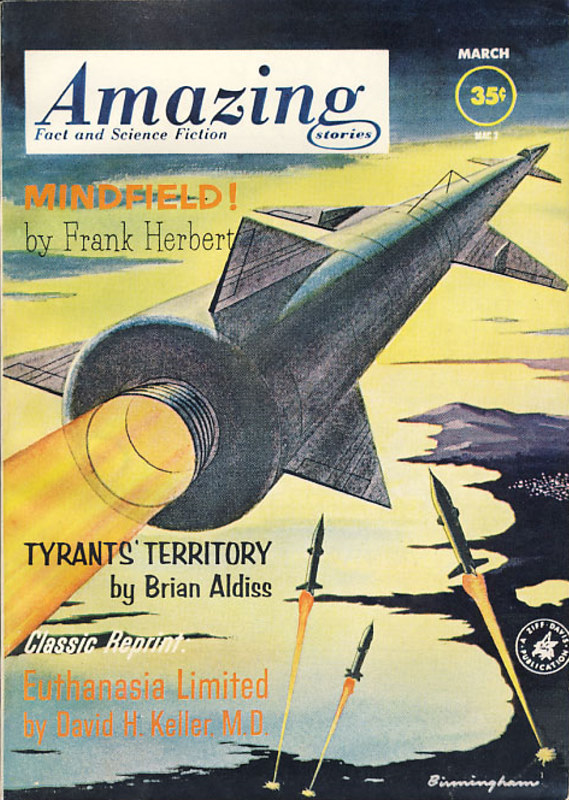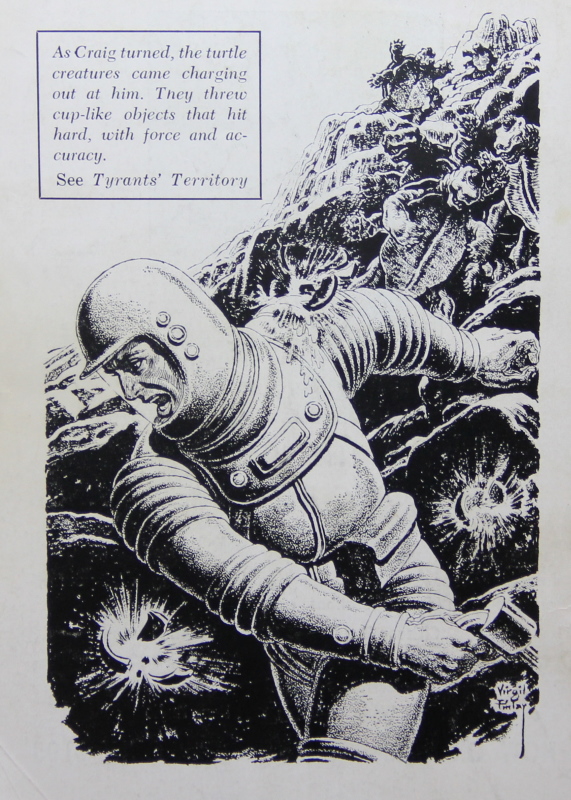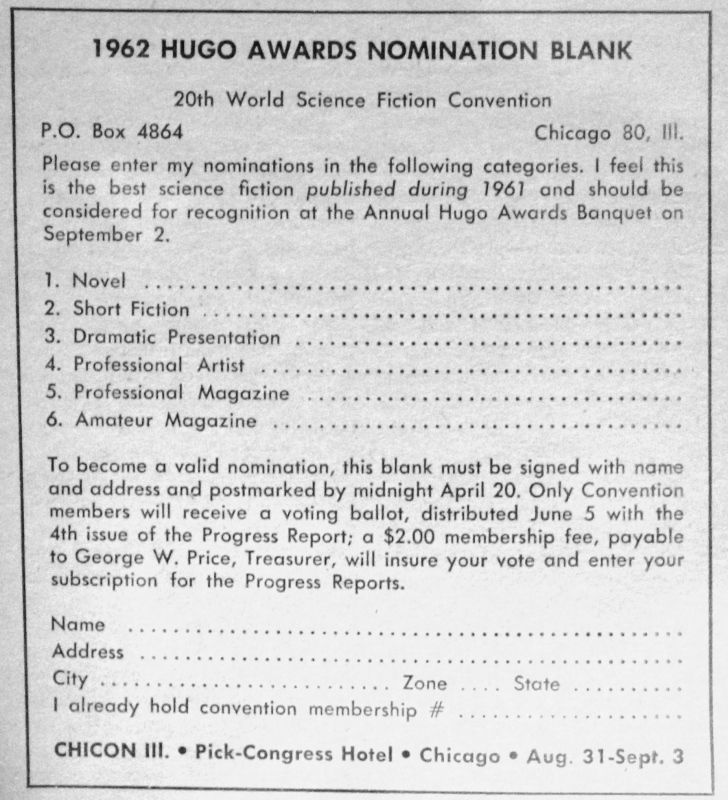
by John Boston
A couple of months ago I described Amazing, as “promising.” Now here’s the March 1962 issue, with two up-and-comers on the cover and a third on the contents page.
Verdict: promise partly kept.

Maybe “up-and-comer” isn’t quite le mot juste for Frank Herbert; “what have you done for me lately?” might fit better. Herbert’s reputation was made by the very well-received Under Pressure, a/k/a The Dragon in the Sea and . . . [gag] . . . 21st Century Sub. But there’s been no new novel, and the short fiction, though much of it is very solid, has not delivered on expectations. Mindfield!, the lead novelette, doesn’t advance things. After a cataclysmic war, a religious tyranny suppresses the old technology, but young rebels want knowledge and progress! This unoriginal premise is decorated with some original details, e.g., everyone is conditioned against violence, and the priests must regularly undergo “Ultimate Conditioning” in some sort of ego-dissolving regeneration tank.
The story is pretty murky, so I’ll leave it at this detail: The rebels have found an ancient skeleton and have put that into their stolen regeneration tank, and the simulacrum that emerges remembers its name (barely), and later, how to pilot a helicopter. No disrespect to bones—where would we be without them?—but how do you get memory and complex skills out of them? The answer: mumble mumble handwave, and not much of that. This reads like an exercise in sauve qui peut, to salvage something from a larger project that didn’t pan out. Two stars.
Mindfield! is illustrated on the cover, sort of: it portrays a missile launch that is about to happen at the end. It’s consistent with Amazing’s habit of featuring machinery on the cover, but this is rather wimpy machinery: the artist Lloyd Birmingham seems to have used some medium like chalk or colored pencil rather than good old forceful oils or the new acrylics. Lackluster!
Briton Brian W. Aldiss is definitely up and coming, now prolific in the US as well as the UK, and known for pushing the envelope and/or kicking the shins of standard SF practice. So Tyrants’ Territory, featuring planetary exploration and a science puzzle, played very straight, is a surprise. Askanza VI has huge mineral-filled oceans and littoral fauna that look like giant turtles, who build rudimentary structures and throw crockery full of acid when threatened. Their heads are literally empty. What’s going on? The heads of the turtles, or more properly pseudo-chelonia (Aldiss has a footnote about that term), are radio receivers; they are guided by radio waves from the ocean, which by virtue of its composition, is a low-power transmitter. Who’s transmitting, or whether there is some sort of collective mind, is not clear—but once human colonists arrive, they will quickly figure out how to control the pseudo-chelonia, and the worst elements among them will do so—hence the title.
But why allow human colonists at all where there already is intelligent life? Uncharacteristically for Aldiss, there’s no real questioning of the colonial imperative beyond the protagonist’s bad mood. The only discordant note is the name of this venture—the Planetary Ecological Survey Team, or PEST—but that’s it for moral witness. Nonetheless, the story is so well conceived, written, and assembled as to merit four stars.

J.G. Ballard is back with The Thousand Dreams of Stellavista , another in his series about Vermilion Sands — a colony of artists and other creative types, not to mention layabouts and poseurs. It introduces psychotropic houses, which reflect the emotional states and physical reactions of their occupants—including their previous occupants. This idea is good for gags early on, e.g.: “Rapidly we went through a mock Assyrian ziggurat (the last owner had suffered from St. Vitus’s Dance, and the whole structure still jittered like a galvanized Tower of Pisa).”
Protagonist Talbot and wife buy the house once belonging to Gloria Tremayne, a movie star who shot and killed her husband in the house but was acquitted of murder—with Talbot assisting her defense. He’s never gotten over his fascination. The relationship between Talbot and his wife and the house’s memory of Tremayne and her husband reinforce each other until the house tries first to kill Talbot’s wife and then to kill Talbot when he comes home drunk and aggressive, not unlike Tremayne’s husband. Talbot has, as he later puts it, “reconstructed the original traumatic situation in order to release the repressed material.”
This superficially jokey story is extremely well done. Apart from the cleverness of the idea and its development, Ballard (like Aldiss) is a vastly better writer at the word-and-sentence level than the genre standard, with a knack for striking phrases and images (“Starting to walk down to the lounge, I realized that the house was watching me like a wounded animal.”). The portrayal of Talbot as a narcissistic jerk through his first-person narration is a little tour de force of “show, don’t tell.” Four stars.
Newish writer David Ely is here with The The Wizard of Light, in which multiple copies of artistic masterpieces appear, utterly indistinguishable from the originals—like hundreds of Mona Lisas left outside the Louvre. The art market is destroyed. Turns out old Dr. Browl, brilliant inventor of optical devices, has invented a molecular scanner, complete with “cybernetic reactor” to copy whatever was scanned. And why is he doing this? To destroy art, which “falsifies nature in general, and light values in particular.” Clever idea, but spun out for too long, and the story is told in a faux-19th Century verbose style; whether as pastiche or just reinventing the square wheel, it talks itself down to three stars.
The Classic Reprint this issue is Euthanasia Limited by David H. Keller, M.D., a power in his time (the 1920s and ‘30s). It features detective Taine of San Francisco. Sam Moskowitz’s introduction says Keller “performed a feat of characterization [with Taine] so extraordinary that it should be studied by every student of writing technique.” Whatever. It begins: “A little white-haired woman was working in her laboratory.” Not bad for 1929! Anna Van Why (honest) is making a battery—out of apple halves. She studies death and has learned that all life has electrical potential, and death is its reduction to zero, as she explains for not quite four pages. Her sociopathic brother is eager to learn more, and a year later a police official comes to discuss with her a series of unusual deaths and arrange a visit from Taine. Taine arrives and cracks the by now obvious case through tedious chicanery. To hell with this, bring back Anna Van Why! Two stars.
Frank Tinsley contributes Cosmic Butterfly, a short article about a spaceship design that uses solar power to ionize a propellant. Tinsley is a fairly boring writer and this is pitched at a level more elementary than most SF readers are likely to need. Two stars.
In 1956, F&SF began running a series of vignettes titled Through Time and Space with Ferdinand Feghoot, by one Grendel Briarton (hint: think anagram), consisting of elaborate set-ups for terrible puns, usually on cliched sayings. Now Amazing has commenced Through Time and Space with Benedict Breadfruit, by one Grandall Barretton (not even quite an anagram), consisting of elaborate set-ups for terrible puns on the names of SF authors. This has been a public service announcement.
[Speaking of which, if you registered for WorldCon by January 31, you should have received your ballot. Don't forget to nominate Galactic Journey for "Best Fanzine!"]


Frank Herbert is, for me, an odd case. He has fascinating ideas and writes well, I generally enjoy what I've read, and yet I come away feeling not completely satisfied. It's like a tasty meal that is a pleasure to eat, but neither stills hunger nor offers much in the way of nutrition. He's been at this for a few years now, but I have hopes that he'll eventually rise to the potential he obviously has.
I've said before that Aldiss never quite "clicks" for me, despite his clear skill. "Tyrant's Territory" certainly fits the bill (though I did like it a lot more than the "Hothouse" stories!). Overly long and the whole thing never quite gels. Much the same can be said of my few encounters with Ballard.
I didn't think all that much of the Ely, either. Maybe I just couldn't accept Browl's motivations. For all that scientists in fiction are cold and unmoved by art and beauty, I've yet to meet one in real life who didn't have a passion for art, literature, or music. The economic argument also made no sense. Considering the popularity of art prints, how much more popular would perfect replicas be? Records and radio have hardly killed music. The only people affected by this perfect replication would be those art dealers who sell the works of famous (and generally dead) artists. The whole thing was poorly thought out.
I admit it. I like the Feghoots. However, Randy Garrett should stick to his last and leave the humor to others. He's just not as clever as he thinks he is.
I agree with Demetrios about Aldiss, and this one is definitely sloppy. I'm afraid I don't like the Keller either; I can't really see a vivisectionist as a sweet and innocent person.
I do like the Ely. It's well written, and seems to be strongly influenced by Jorkens, whose Adventures I like a lot. And Ballard writes enjoyable fic about his colony of third rate and coddled artistes.
I found the Herbert to be novel and sufficiently complex to hold my interest. It's true that he seems to be struggling to reach the level of "Under Pressure" again, and some of his short stories have been disappointing, but this one was pretty good.
The Aldiss read almost like something from "Analog," except for the pessimistic ending. Not bad at all.
I very much like Ballard's style, and I'm a sucker for the decadent mood and artistic images of the Vermilion Sands series, so that was my favorite story in the issue.
It's downhill from there. The Ely was simple and had a poor ending. Too bad, because I've enjoyed a couple of his stories in "Fantastic."
I didn't even bother reading the Keller, both because of your review and because these "classic reprints" have been, on the whole, tiresome. I guess I just don't have the right attitude to appreciate Gernsback era SF.
The science article was OK.
The less said about the pun the better.
Overall, looks like "Amazing" is heading the right way.
I wholeheartedly agree. The Aldiss lost me about halfway, but the Ballard was like a cross between Perry Mason and Heinlein's And he Built a Crooked House. Fine stuff deserving of four stars.
I too though of Crooked House. The story also made me think of the movie Sunset Boulevard.
I have a feeling the Ballard story would never have made it through former editor Paul Fairman's quality control…
> apple
Well, I built one of the radios from Gernsback's "Electrical Experimenter" magazine when I was a kid. It was a crystal set that used a potato as a battery. It worked well enough to listen to the local AM station.
My mom was upset over that radio and we didn't eat potatoes much after that. And she bought packs of those little plastic plugs that pressed into the wall sockets so electricity wouldn't leak out; you had to lever them out with a butter knife every time you wanted to plug something in.